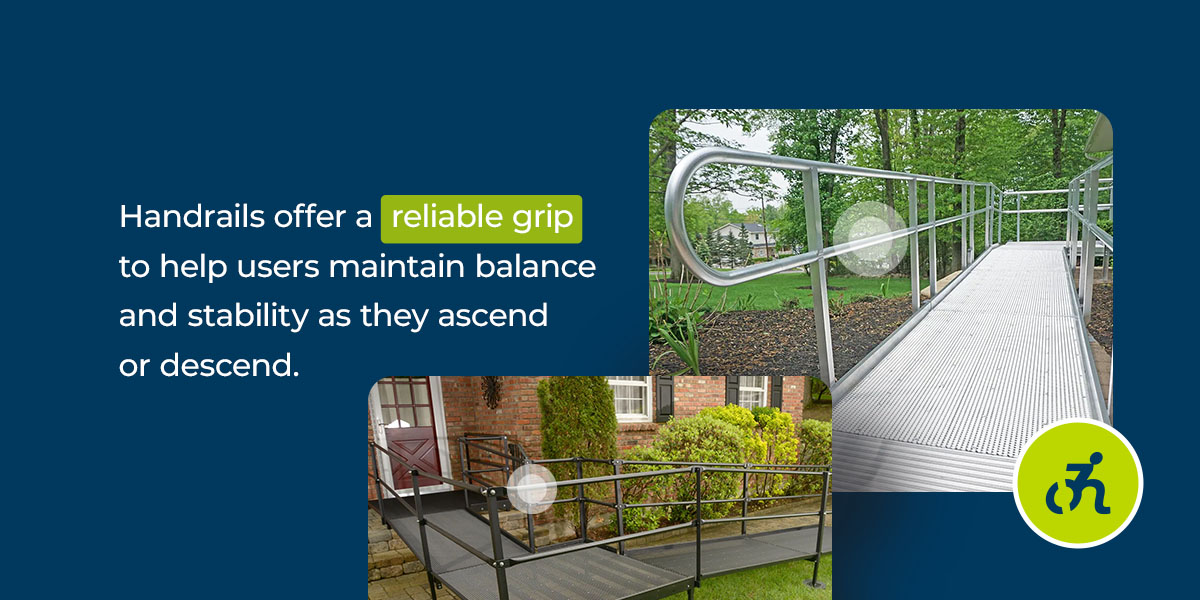
Wheelchair ramps provide well-deserved mobility and independence when entering a home or accessing public spaces. If you plan to install this feature, you should first understand what makes a user-friendly ramp. You must also consider various ramp features that impact safety.
This guide explores these crucial concerns. You can use this advice to select a ramp that meets your needs and provides valuable peace of mind for you and your loved ones.
Top 9 Wheelchair Ramp Safety Features
Always keep the following features at the top of your mind when shopping for a new wheelchair ramp.
1. Non-Slip Surface
A non-slip surface is a critical safety feature for using a ramp in damp, rainy or icy conditions. Wheelchair users and their caregivers need enough traction to reduce the risk of slips and falls.
A reliable, non-slip surface ensures stability and confidence when dealing with rain, ice, snow or morning dew. Look for ramps with textured materials or coatings designed to enhance grip, even in adverse weather conditions.
2. Appropriate Slope
The last thing you want is a too-steep ramp when entering or exiting your home. The slope is critical for safety and ease of use.
A ramp with an appropriate slope allows people to use it comfortably without exerting excessive effort. It ensures a smooth and manageable ascent or descent angle while minimizing the risk of accidents such as tipping backward or forward. It’s all about finding balance — not too steep to be daunting, but not too shallow to be ineffective.
3. Weather Protection
Don’t forget the weather when investing in a wheelchair ramp. Harsh conditions like rain, snow or extreme sun can make using a ramp challenging and dangerous. That’s why choosing weather protection features is a smart move.
Ramps with canopies or shelters shield users from the elements. These protective covers can keep people dry and comfortable and maintain the ramp materials’ integrity over time.
4. Strength
A sturdy ramp provides stability and instills confidence in wheelchair users and caregivers. Choose a ramp constructed from durable materials like aluminum or steel that can support the user and their mobility device.
A robust ramp ensures smooth and safe transitions, even for heavier power wheelchairs or scooters. It’s an invaluable investment in your peace of mind.
5. Adequate Width and Weight Capacity
A wheelchair ramp should have sufficient width to accommodate different wheelchair sizes and allow space for caregivers to assist users comfortably. A ramp that’s at least 36 inches wide provides ample space for comfortable maneuvering. The vertical clearance above the ramp should also be sufficient to prevent head injuries and ensure unobstructed passage.
Additionally, consider weight capacity. A sturdy ramp capable of holding 800 pounds or more ensures stability for users. It should support the combined weight of the wheelchair, user and caregiver without bending or breaking.
Installing a ramp with adequate width and weight capacity ensures safe and convenient access for users and caregivers.
6. Handrails

A ramp with nothing to hold onto is a recipe for disaster. Handrails offer a reliable grip to help users maintain balance and stability as they ascend or descend. They can also be a vital safety measure — if someone falls, they can catch themselves and prevent injury. While handrails may not be mandatory for all ramp installations, they are essential for longer ramps or those with steeper inclines.
7. Edge Protection
With no edge protection on a ramp’s sides, it’s easy for a wheel to slip off the edge, leading to an accident or injury. That’s where edge protection comes in. Installing barriers or curbs along the sides creates a protective border that keeps wheelchairs from deviating off course.
These safeguards offer people more confidence and reassurance as they traverse the ramp. Additionally, edge protection provides a path and reduces the risk of accidental falls.
8. Visual and Tactile Cues
Incorporating visual contrast, such as color variations or striping, on the ramp surface can help people with visual impairments distinguish the ramp from surrounding areas. Tactile warning strips at the top and bottom of the ramp alert users of elevation changes.
9. Level Landings
Level landings at the top and bottom provide a stable platform to rest, maneuver and safely open doors. These flat surfaces are essential to maintain control and stability, especially when transitioning between the ramp and adjacent areas. Level landings allow wheelchair users to turn or stop as needed without feeling unbalanced or rushed.
How to Choose the Right Ramp
Here are some essential steps to guide you through the selection process.
- Prioritize safety features: Identify must-have features like non-slip surfaces, sturdy handrails and edge protection to ensure maximum safety.
- Assess individual needs: Think about the primary ramp users’ daily needs. Identify the mobility aid they use, the frequency of use and their preferences or requirements.
- Understand local regulations and standards: You must understand your area’s slope requirements, handrail specifications and other relevant standards. Research local building codes and accessibility guidelines to ensure compliance with safety regulations.
- Evaluate location and space constraints: Measure the available space for ramp installation and consider factors such as terrain and weather conditions. Choose a ramp configuration that fits the designated area and provides safe access to the entry points.
- Consult with professionals: Seek guidance from reputable ramp manufacturers or installation professionals. They can provide expertly tailored advice and help you make informed decisions.

Call a Mobility Consultant Today
What makes a wheelchair ramp safe? It isn’t only the inclusion of essential wheelchair ramp safety features. These vital investments keep the ramp functional, secure and reliable, providing reassurance and ease of use for people and their loved ones.
Browse our online catalog if you need a ramp to improve accessibility at your home or business. We offer various ramps designed to meet diverse needs while prioritizing safety and quality.
We understand how challenging it can be to buy a ramp, so we’re here to simplify your decision. Feel free to contact us online or call us at 877-564-4355 to talk to a mobility consultant.
Don’t Risk Injury To You Or A Loved One
Why wait? Give us a call at 877-596-7293 or contact us online to get started!